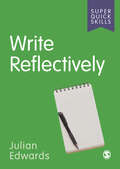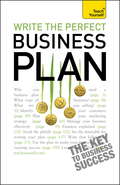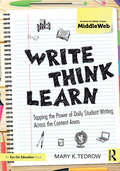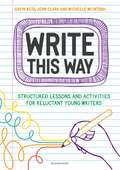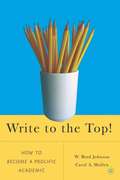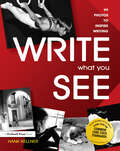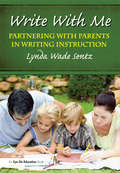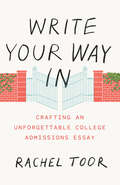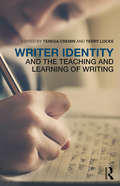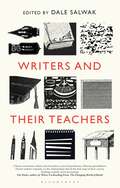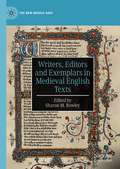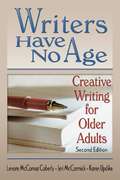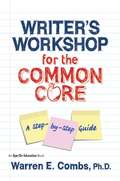- Table View
- List View
Write Reflectively (Super Quick Skills)
by Julian EdwardsYour step-by-step guide to reflective writing, this book gives you the practical skills to reflect on and learn from your experiences. With a clear framework that works for different situations and types of assignments, learn how to: · Take the time and space to reflect · Find a structure and writing style to communicate your experiences · Solve real-world problems · Set goals for future action Super Quick Skills provide the essential building blocks you need to succeed at university - fast. Packed with practical, positive advice on core academic and life skills, you’ll discover focused tips and strategies to use straight away. Whether it’s writing great essays, understanding referencing or managing your wellbeing, find out how to build good habits and progress your skills throughout your studies. Learn core skills quickly Apply right away and see results Succeed in your studies and life. Super Quick Skills give you the foundations you need to confidently navigate the ups and downs of university life.
Write the Perfect Business Plan: Teach Yourself (Teach Yourself)
by Polly BirdBusinesses involved in preparing a business plan need guidance on what to present, and how to present it. This book is primarily aimed at new businesses and the self-employed, but it will also be useful to any business that has to raise a financial case during the course of their trading. Straightforward advice is given about what to consider and include in the plan, and how to present it.NOT GOT MUCH TIME?One, five and ten-minute introductions to key principles to get you started.AUTHOR INSIGHTSLots of instant help with common problems and quick tips for success, based on the author's many years of experience.TEST YOURSELFTests in the book and online to keep track of your progress.EXTEND YOUR KNOWLEDGEExtra online articles at www.teachyourself.com to give you a richer understanding of business planning.THINGS TO REMEMBERQuick refreshers to help you remember the key facts.TRY THISInnovative exercises illustrate what you've learnt and how to use it.
Write, Think, Learn: Tapping the Power of Daily Student Writing Across the Content Areas
by Mary K. TedrowFind out how to create the climate and space for everyday student writing. In this new co-publication with MiddleWeb, award-winning teacher Mary Tedrow shows you how to encourage students to integrate daily writing into their lives, leading to improved critical thinking skills, increased knowledge of subject areas, and greater confidence in written expression. This practical guide will help you consider the unique needs of your students, while still meeting state standards. You’ll discover how to… Develop classroom routines and activities that invite creativity and self-expression Teach writing methods that can be used across different grade levels and all content areas Challenge students to examine their own writing processes for thinking and problem solving Evaluate written work in a way that emphasizes growth over grades Many exercises, prompts, and attempts at thinking found in the book can be easily adapted for use both in and out of the classroom. Whether you are a new or experienced teacher, Write, Think, Learn will enable you to make writing come alive for all your students.
Write, Think, Learn: Tapping the Power of Daily Student Writing Across the Content Areas
by Mary K. TedrowFind out how to create the climate and space for everyday student writing. In this new co-publication with MiddleWeb, award-winning teacher Mary Tedrow shows you how to encourage students to integrate daily writing into their lives, leading to improved critical thinking skills, increased knowledge of subject areas, and greater confidence in written expression. This practical guide will help you consider the unique needs of your students, while still meeting state standards. You’ll discover how to… Develop classroom routines and activities that invite creativity and self-expression Teach writing methods that can be used across different grade levels and all content areas Challenge students to examine their own writing processes for thinking and problem solving Evaluate written work in a way that emphasizes growth over grades Many exercises, prompts, and attempts at thinking found in the book can be easily adapted for use both in and out of the classroom. Whether you are a new or experienced teacher, Write, Think, Learn will enable you to make writing come alive for all your students.
Write This Way: Structured lessons and activities for reluctant young writers
by Dr. Gavin Reid Jenn Clark Michelle McIntoshMany children avoid writing for a number of reasons – perhaps they find it tedious or frustrating, or perhaps they have dyslexia or dysgraphia. This structured programme of writing activities and lessons makes writing engaging and accessible for reluctant writers, by encouraging primary teachers and learners to work together to develop children's writing skills.The book covers all aspects of primary school writing, including grammar, sentence development, punctuation, paragraph writing and planning. It also shows teachers how to develop self-sufficiency skills in writing and encourage learner independence. Each section in the book builds on previous skills learned, from word level up to creative writing skills, providing pupils with a complete range of writing tools. The ready-to-use resources for each topic - including mini lessons, discovery tools and activities - offer extensions and adaptations to suit all pupil needs, including fun ideas for multisensory learning, group interventions or to keep pupils learning outside of the classroom.For school staff working with children who find writing challenging, this practical toolkit provides a range of activities based on solid research and hands-on experience that can be incorporated straight into lessons and teaching practices.
Write This Way: Structured lessons and activities for reluctant young writers
by Dr. Gavin Reid Jenn Clark Michelle McIntoshMany children avoid writing for a number of reasons – perhaps they find it tedious or frustrating, or perhaps they have dyslexia or dysgraphia. This structured programme of writing activities and lessons makes writing engaging and accessible for reluctant writers, by encouraging primary teachers and learners to work together to develop children's writing skills.The book covers all aspects of primary school writing, including grammar, sentence development, punctuation, paragraph writing and planning. It also shows teachers how to develop self-sufficiency skills in writing and encourage learner independence. Each section in the book builds on previous skills learned, from word level up to creative writing skills, providing pupils with a complete range of writing tools. The ready-to-use resources for each topic - including mini lessons, discovery tools and activities - offer extensions and adaptations to suit all pupil needs, including fun ideas for multisensory learning, group interventions or to keep pupils learning outside of the classroom.For school staff working with children who find writing challenging, this practical toolkit provides a range of activities based on solid research and hands-on experience that can be incorporated straight into lessons and teaching practices.
Write to the Top!: How to Become a Prolific Academic
by W. Johnson C. MullenThis is a pithy, no-nonsense, no-excuses guide to maximizing the quality and quantity of your scholarly products. Write to the Top! offers an accessible overview of the art of writing efficiently and effectively; it is the first book that explicitly summarizes the key elements to prolific productivity in academic settings.
Write What You See: 99 Photos to Inspire Writing (Grades 7-12)
by Hank KellnerMotivate your students with the wide variety of photographs and writing prompts in this delightful book by award-winning photographer and former English teacher Hank Kellner.The varied prompts include key words, questions to consider, ideas for writing, possible opening lines, suggestions for research, and more. The book even comes with a CD so that you have the option of displaying the activities with an overhead projector.Write What You See contains a wealth of ideas for writing from the author as well as from real teachers across the country who have successfully used photography in the teaching of writing.Grades 7-12
Write What You See: 99 Photos to Inspire Writing (Grades 7-12)
by Hank KellnerMotivate your students with the wide variety of photographs and writing prompts in this delightful book by award-winning photographer and former English teacher Hank Kellner.The varied prompts include key words, questions to consider, ideas for writing, possible opening lines, suggestions for research, and more. The book even comes with a CD so that you have the option of displaying the activities with an overhead projector.Write What You See contains a wealth of ideas for writing from the author as well as from real teachers across the country who have successfully used photography in the teaching of writing.Grades 7-12
Write With Me: Partnering With Parents in Writing Instruction
by Lynda SentzIn this book, teacher and author Lynda Wade Sentz presents innovative strategies for involving parents in their children’s writing instruction. Elementary school teachers can use these strategies to expand writing instruction into the home and enlist parents as “writing role models” who help to reinforce classroom learning. Designed for use in conjunction with your current writing program, these activities are engaging and enjoyable. They include the Partner Journal and the Partner Scrapbook, along with several others that enable parents and children to communicate via the written word.
Write With Me: Partnering With Parents in Writing Instruction
by Lynda SentzIn this book, teacher and author Lynda Wade Sentz presents innovative strategies for involving parents in their children’s writing instruction. Elementary school teachers can use these strategies to expand writing instruction into the home and enlist parents as “writing role models” who help to reinforce classroom learning. Designed for use in conjunction with your current writing program, these activities are engaging and enjoyable. They include the Partner Journal and the Partner Scrapbook, along with several others that enable parents and children to communicate via the written word.
Write Your Way In: Crafting an Unforgettable College Admissions Essay (Chicago Guides to Writing, Editing, and Publishing)
by Rachel ToorWriting, for most of us, is bound up with anxiety. It’s even worse when it feels like your whole future—or at least where you’ll spend the next four years in college—is on the line. It’s easy to understand why so many high school seniors put off working on their applications until the last minute or end up with a generic and clichéd essay. The good news? You already have the “secret sauce” for crafting a compelling personal essay: your own experiences and your unique voice. The best essays rarely catalog how students have succeeded or achieved. Good writing shows the reader how you’ve struggled and describes mistakes you’ve made. Excellent essays express what you’re fired up about, illustrate how you think, and illuminate the ways you’ve grown. More than twenty million students apply to college every year; many of them look similar in terms of test scores, grades, courses taken, extracurricular activities. Admissions officers wade through piles of files. As an applicant, you need to think about what will interest an exhausted reader. What can you write that will make her argue to admit you instead of the thousands of other applicants? A good essay will be conversational and rich in vivid details, and it could only be written by one person—you. This book will help you figure out how to find and present the best in yourself. You’ll acquire some useful tools for writing well—and may even have fun—in the process.
Write Your Way In: Crafting an Unforgettable College Admissions Essay (Chicago Guides to Writing, Editing, and Publishing)
by Rachel ToorWriting, for most of us, is bound up with anxiety. It’s even worse when it feels like your whole future—or at least where you’ll spend the next four years in college—is on the line. It’s easy to understand why so many high school seniors put off working on their applications until the last minute or end up with a generic and clichéd essay. The good news? You already have the “secret sauce” for crafting a compelling personal essay: your own experiences and your unique voice. The best essays rarely catalog how students have succeeded or achieved. Good writing shows the reader how you’ve struggled and describes mistakes you’ve made. Excellent essays express what you’re fired up about, illustrate how you think, and illuminate the ways you’ve grown. More than twenty million students apply to college every year; many of them look similar in terms of test scores, grades, courses taken, extracurricular activities. Admissions officers wade through piles of files. As an applicant, you need to think about what will interest an exhausted reader. What can you write that will make her argue to admit you instead of the thousands of other applicants? A good essay will be conversational and rich in vivid details, and it could only be written by one person—you. This book will help you figure out how to find and present the best in yourself. You’ll acquire some useful tools for writing well—and may even have fun—in the process.
Write Your Way In: Crafting an Unforgettable College Admissions Essay (Chicago Guides to Writing, Editing, and Publishing)
by Rachel ToorWriting, for most of us, is bound up with anxiety. It’s even worse when it feels like your whole future—or at least where you’ll spend the next four years in college—is on the line. It’s easy to understand why so many high school seniors put off working on their applications until the last minute or end up with a generic and clichéd essay. The good news? You already have the “secret sauce” for crafting a compelling personal essay: your own experiences and your unique voice. The best essays rarely catalog how students have succeeded or achieved. Good writing shows the reader how you’ve struggled and describes mistakes you’ve made. Excellent essays express what you’re fired up about, illustrate how you think, and illuminate the ways you’ve grown. More than twenty million students apply to college every year; many of them look similar in terms of test scores, grades, courses taken, extracurricular activities. Admissions officers wade through piles of files. As an applicant, you need to think about what will interest an exhausted reader. What can you write that will make her argue to admit you instead of the thousands of other applicants? A good essay will be conversational and rich in vivid details, and it could only be written by one person—you. This book will help you figure out how to find and present the best in yourself. You’ll acquire some useful tools for writing well—and may even have fun—in the process.
Write Your Way In: Crafting an Unforgettable College Admissions Essay (Chicago Guides to Writing, Editing, and Publishing)
by Rachel ToorWriting, for most of us, is bound up with anxiety. It’s even worse when it feels like your whole future—or at least where you’ll spend the next four years in college—is on the line. It’s easy to understand why so many high school seniors put off working on their applications until the last minute or end up with a generic and clichéd essay. The good news? You already have the “secret sauce” for crafting a compelling personal essay: your own experiences and your unique voice. The best essays rarely catalog how students have succeeded or achieved. Good writing shows the reader how you’ve struggled and describes mistakes you’ve made. Excellent essays express what you’re fired up about, illustrate how you think, and illuminate the ways you’ve grown. More than twenty million students apply to college every year; many of them look similar in terms of test scores, grades, courses taken, extracurricular activities. Admissions officers wade through piles of files. As an applicant, you need to think about what will interest an exhausted reader. What can you write that will make her argue to admit you instead of the thousands of other applicants? A good essay will be conversational and rich in vivid details, and it could only be written by one person—you. This book will help you figure out how to find and present the best in yourself. You’ll acquire some useful tools for writing well—and may even have fun—in the process.
Write Your Way In: Crafting an Unforgettable College Admissions Essay (Chicago Guides to Writing, Editing, and Publishing)
by Rachel ToorWriting, for most of us, is bound up with anxiety. It’s even worse when it feels like your whole future—or at least where you’ll spend the next four years in college—is on the line. It’s easy to understand why so many high school seniors put off working on their applications until the last minute or end up with a generic and clichéd essay. The good news? You already have the “secret sauce” for crafting a compelling personal essay: your own experiences and your unique voice. The best essays rarely catalog how students have succeeded or achieved. Good writing shows the reader how you’ve struggled and describes mistakes you’ve made. Excellent essays express what you’re fired up about, illustrate how you think, and illuminate the ways you’ve grown. More than twenty million students apply to college every year; many of them look similar in terms of test scores, grades, courses taken, extracurricular activities. Admissions officers wade through piles of files. As an applicant, you need to think about what will interest an exhausted reader. What can you write that will make her argue to admit you instead of the thousands of other applicants? A good essay will be conversational and rich in vivid details, and it could only be written by one person—you. This book will help you figure out how to find and present the best in yourself. You’ll acquire some useful tools for writing well—and may even have fun—in the process.
Write Your Way In: Crafting an Unforgettable College Admissions Essay (Chicago Guides to Writing, Editing, and Publishing)
by Rachel ToorWriting, for most of us, is bound up with anxiety. It’s even worse when it feels like your whole future—or at least where you’ll spend the next four years in college—is on the line. It’s easy to understand why so many high school seniors put off working on their applications until the last minute or end up with a generic and clichéd essay. The good news? You already have the “secret sauce” for crafting a compelling personal essay: your own experiences and your unique voice. The best essays rarely catalog how students have succeeded or achieved. Good writing shows the reader how you’ve struggled and describes mistakes you’ve made. Excellent essays express what you’re fired up about, illustrate how you think, and illuminate the ways you’ve grown. More than twenty million students apply to college every year; many of them look similar in terms of test scores, grades, courses taken, extracurricular activities. Admissions officers wade through piles of files. As an applicant, you need to think about what will interest an exhausted reader. What can you write that will make her argue to admit you instead of the thousands of other applicants? A good essay will be conversational and rich in vivid details, and it could only be written by one person—you. This book will help you figure out how to find and present the best in yourself. You’ll acquire some useful tools for writing well—and may even have fun—in the process.
Writer Identity and the Teaching and Learning of Writing
by Teresa Cremin Terry LockeWriter Identity and the Teaching and Learning of Writing is a groundbreaking book which addresses what it really means to identify as a writer in educational contexts and the implications for writing pedagogy. It conceptualises writers’ identities, and draws upon empirical studies to explore their construction, enactment and performance. Focusing largely on teachers’ identities and practices as writers and the writer identities of primary and secondary students, it also encompasses the perspectives of professional writers and highlights promising new directions for research. With four interlinked sections, this book offers: Nuanced understandings of how writer identities are shaped and formed; Insights into how classroom practice changes when teachers position themselves as writers alongside their students; New understandings of what this positioning means for students’ identities as writers and writing pedagogy; and Illuminating case studies mapping young people's writing trajectories. With an international team of contributors, the book offers a global perspective on this vital topic, and makes a new and strongly theorised contribution to the field. Viewing writer identity as fluid and multifaceted, this book is important reading for practising teachers, student teachers, educational researchers and practitioners currently undertaking postgraduate studies. Contributors include: Teresa Cremin, Terry Locke, Sally Baker, Josephine Brady, Diane Collier, Nikolaj Elf, Ian Eyres, Theresa Lillis, Marilyn McKinney, Denise Morgan, Debra Myhill, Mary Ryan, Kristin Stang, Chris Street, Anne Whitney and Rebecca Woodard.
Writer Identity and the Teaching and Learning of Writing
by Teresa Cremin Terry LockeWriter Identity and the Teaching and Learning of Writing is a groundbreaking book which addresses what it really means to identify as a writer in educational contexts and the implications for writing pedagogy. It conceptualises writers’ identities, and draws upon empirical studies to explore their construction, enactment and performance. Focusing largely on teachers’ identities and practices as writers and the writer identities of primary and secondary students, it also encompasses the perspectives of professional writers and highlights promising new directions for research. With four interlinked sections, this book offers: Nuanced understandings of how writer identities are shaped and formed; Insights into how classroom practice changes when teachers position themselves as writers alongside their students; New understandings of what this positioning means for students’ identities as writers and writing pedagogy; and Illuminating case studies mapping young people's writing trajectories. With an international team of contributors, the book offers a global perspective on this vital topic, and makes a new and strongly theorised contribution to the field. Viewing writer identity as fluid and multifaceted, this book is important reading for practising teachers, student teachers, educational researchers and practitioners currently undertaking postgraduate studies. Contributors include: Teresa Cremin, Terry Locke, Sally Baker, Josephine Brady, Diane Collier, Nikolaj Elf, Ian Eyres, Theresa Lillis, Marilyn McKinney, Denise Morgan, Debra Myhill, Mary Ryan, Kristin Stang, Chris Street, Anne Whitney and Rebecca Woodard.
Writers and Their Teachers
by Dale SalwakBy turns reflective, entertaining and moving, this book reveals how some of the most influential and best loved writers of our time were shaped by their inspirational teachers. Nobel laureate J. M. Coetzee, Margaret Drabble, Stephen Greenblatt, Ngugi wa Thiong'o, Andrew Motion, Gretchen Holbrook Gerzina and Paul Theroux are among the twenty contributors of original essays to this landmark volume celebrating masters of the teaching profession.What makes a good teacher? What lights the writer's creative fire? How can the teacher shape the writer? This book answers these questions and more, describing the powerful influence of mentors at an impressionable time of life, portraying the heart-warming transition from pupil to friend, and exploring the lasting impact that truly great teachers can have on their students.To have teachers who care, and to have such notable writers capture their spirit, is ample reason to read Dale Salwak's elegant celebration of the 'noble profession' and the world-renowned writers that it helped to hone.
Writers and Their Teachers
By turns reflective, entertaining and moving, this book reveals how some of the most influential and best loved writers of our time were shaped by their inspirational teachers. Nobel laureate J. M. Coetzee, Margaret Drabble, Stephen Greenblatt, Ngugi wa Thiong'o, Andrew Motion, Gretchen Holbrook Gerzina and Paul Theroux are among the twenty contributors of original essays to this landmark volume celebrating masters of the teaching profession.What makes a good teacher? What lights the writer's creative fire? How can the teacher shape the writer? This book answers these questions and more, describing the powerful influence of mentors at an impressionable time of life, portraying the heart-warming transition from pupil to friend, and exploring the lasting impact that truly great teachers can have on their students.To have teachers who care, and to have such notable writers capture their spirit, is ample reason to read Dale Salwak's elegant celebration of the 'noble profession' and the world-renowned writers that it helped to hone.
Writers, Editors and Exemplars in Medieval English Texts (The New Middle Ages)
by Sharon M. RowleyThis collection of essays explores the literary legacy of medieval England by examining the writers, editors and exemplars of medieval English texts. In order to better understand the human agency, creativity and forms of sanctity of medieval England, these essays investigate both the production of medieval texts and the people whose hands and minds created, altered and/or published them. The chapters consider the writings of major authors such as Chaucer, Gower and Wyclif in relation to texts, authors and ideals less well-known today, and in light of the translation and interpretive reproduction of the Bible in Middle English. The essays make some texts available for the first time in print, and examine the roles of historical scholars in the construction of medieval English literature and textual cultures. By doing so, this collection investigates what it means to recover, study and represent some of the key medieval English texts that continue to influence us today.
Writers Have No Age: Creative Writing for Older Adults, Second Edition
by Karen Updike Jeri Mccormick Lenore Mccomas CoberlyWriters Have No Age: Creative Writing for Older Adults, Second Edition is a book for writers by writers. Unlike the first edition, which was aimed at teachers of writing, this edition is aimed at writers themselves. This book will help older writers value themselves and their potential, and increase the pleasure and satisfaction found in writing. It provides both information and inspiration gained from the authors&’ own writing lives and from observation of their students that will help boost writing confidence.Write your way to success-at any age!"We who come to writing do not have to be convinced that there are rewards in store for us. We sense good things ahead and believe in writing&’s benefits." "In this book we have put together some of our own best writing and teaching ideas to help you enjoy the re-creation and stimulation of writing, whatever your age.""Older writers though we are, we do get better at it all the time."-the authors This book combines personal accounts of the authors&’ writing experiences as well as writing instruction and information. It contains numerous writing exercises and assignments to get you started and techniques to keep you at it. It also includes sections that cover all types of writing, including poetry, fiction, and nonfiction. Marketing resources for writers who wish to be published are included.In Writers Have No Age, you will find: authors&’ personal anecdotes-from disappointment to success writing exercises and techniques marketing resources and mediums for writers an editing checklist a list of books and periodicals to help hone writing skills suggestions on teaching or volunteering in nursing homes and much more!Writers Have No Age is a valuable tool for anyone in (or just getting started in) the writing field. Not only will this book help beginners sharpen their writing skills, but it will also help those who have written professionally or personally to reach a wider audience. Add this book to your collection today, and write your way to success!
Writers Have No Age: Creative Writing for Older Adults, Second Edition
by Karen Updike Jeri Mccormick Lenore Mccomas CoberlyWriters Have No Age: Creative Writing for Older Adults, Second Edition is a book for writers by writers. Unlike the first edition, which was aimed at teachers of writing, this edition is aimed at writers themselves. This book will help older writers value themselves and their potential, and increase the pleasure and satisfaction found in writing. It provides both information and inspiration gained from the authors&’ own writing lives and from observation of their students that will help boost writing confidence.Write your way to success-at any age!"We who come to writing do not have to be convinced that there are rewards in store for us. We sense good things ahead and believe in writing&’s benefits." "In this book we have put together some of our own best writing and teaching ideas to help you enjoy the re-creation and stimulation of writing, whatever your age.""Older writers though we are, we do get better at it all the time."-the authors This book combines personal accounts of the authors&’ writing experiences as well as writing instruction and information. It contains numerous writing exercises and assignments to get you started and techniques to keep you at it. It also includes sections that cover all types of writing, including poetry, fiction, and nonfiction. Marketing resources for writers who wish to be published are included.In Writers Have No Age, you will find: authors&’ personal anecdotes-from disappointment to success writing exercises and techniques marketing resources and mediums for writers an editing checklist a list of books and periodicals to help hone writing skills suggestions on teaching or volunteering in nursing homes and much more!Writers Have No Age is a valuable tool for anyone in (or just getting started in) the writing field. Not only will this book help beginners sharpen their writing skills, but it will also help those who have written professionally or personally to reach a wider audience. Add this book to your collection today, and write your way to success!
Writer's Workshop for the Common Core: A Step-by-Step Guide
by Warren CombsWriting instruction expert Warren Combs presents a step-by-step plan for teaching writing workshops that are aligned to the Common Core State Standards. The book is filled with practical mini-lessons, strategies, and tools for every stage of the writing process, from prewriting through publication. Scripting is provided, to show teachers how to model each strategy for students. In addition, Dr. Combs shows how teachers can use the following elements: The concepts Voice, Pictures, and Flow, to help students understand the essential elements of writing; The words Invite, Model, Write, Look, and Learn, to model effective writing for students and have them learn from your example; Revision strategies such as Jot and Blend, Combining Sentences, Writing Leads, and Writing Closes; Peer revision using Peer-Assisted Learning Systems (PALS); Student self-assessment rubrics. The book also includes scoring guides and pacing guides, to help teachers implement writing workshops more easily. As Dr. Combs demonstrates, you can give workshops more structure while still making writing come alive for your students.
